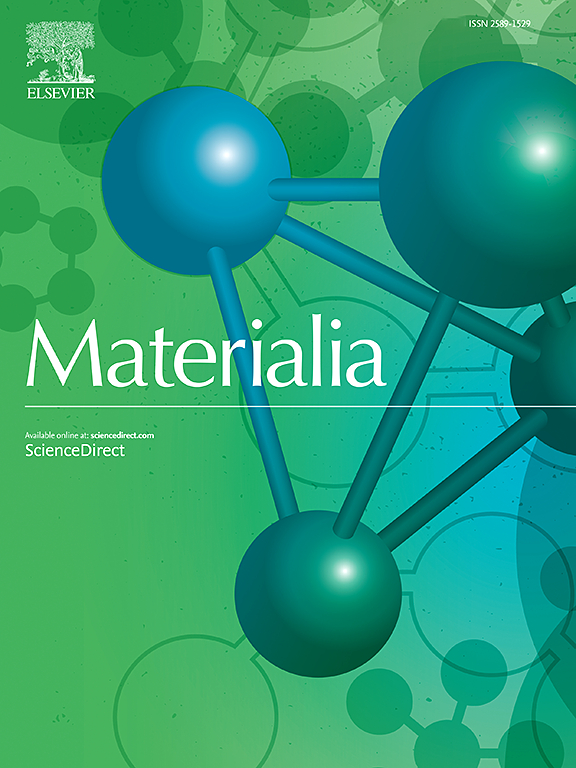Three-stage deformation behaviors of a austenitic Fe-Mn-Al-C low-density steel: slip bands–twinning–shear bands
IF 3
Q2 MATERIALS SCIENCE, MULTIDISCIPLINARY
引用次数: 0
Abstract
This study presents a systematic investigation of microstructure evolution and the mechanical response of a low-density steel during cold rolling with the thickness reduction of up to 90 %. With the strain increase, a three-stage deformation microstructural evolution from slip bands, to deformation twins, and eventually to shear bands has been observed based on detailed microstructure characterization. At the first stage (rolling reduction < 30 %), dislocation slip bands are the dominant deformation microstructure, due to the planar slip of dislocations. As strain increases, the band spacing is progressively refined with a saturation of ∼50 nm. These slip bands gradually evolved into microbands as a result of strain localization and plastic instability. At the second deformation stage (30 %–50 % rolling reduction), deformation twinning is activated, which was seldom reported in low-density steel due to its high stacking fault energy. The deformation twins were found to be preferentially nucleated in the grains with orientations approaching 〈001〉 // rolling direction and 〈111〉 // rolling direction. At the last deformation stage (60 %–90 % rolling reduction), the deformation was mainly controlled by the formation of shear bands, generated in the areas with orientations close to // normal direction. In the mechanical response aspect, the strength was progressively increased with increasing rolling reduction. The formation of deformation twins and shear bands could notably enhance the strength, exhibiting a distinct three-staged mechanical behavior during cold rolling. This research provided a thorough understanding of the distinct microstructure evolution and mechanical response of the low-density steel during cold rolling.

奥氏体Fe-Mn-Al-C低密度钢的三阶段变形行为:滑移带-孪生带-剪切带
本文系统地研究了一种低密度钢在冷轧减薄90%时的组织演变和力学响应。随着应变的增加,变形组织经历了从滑移带到变形孪晶,再到剪切带的三个阶段。在第一阶段(轧制压下<;30%),位错滑移带是主要的变形组织,主要是位错的平面滑移。随着应变的增加,带间距逐渐细化,达到约50 nm的饱和度。由于应变局部化和塑性失稳,这些滑移带逐渐演变成微带。在第二变形阶段(轧制压下量30% ~ 50%),变形孪晶被激活,由于其层错能高,在低密度钢中很少有报道。变形孪晶优先在取向接近< 001 > //和< 111 > //轧制方向的晶粒中形核。在最后变形阶段(60% ~ 90%轧制还原),变形主要受剪切带的形成控制,这些剪切带产生于取向接近< 111 > //法向的区域。在力学响应方面,随着轧制压下量的增加,强度逐渐提高。冷轧过程中变形孪晶和剪切带的形成显著提高了强度,表现出明显的三阶段力学行为。本研究为低密度钢冷轧过程中不同的组织演变和力学响应提供了深入的认识。
本文章由计算机程序翻译,如有差异,请以英文原文为准。
求助全文
约1分钟内获得全文
求助全文
来源期刊

Materialia
MATERIALS SCIENCE, MULTIDISCIPLINARY-
CiteScore
6.40
自引率
2.90%
发文量
345
审稿时长
36 days
期刊介绍:
Materialia is a multidisciplinary journal of materials science and engineering that publishes original peer-reviewed research articles. Articles in Materialia advance the understanding of the relationship between processing, structure, property, and function of materials.
Materialia publishes full-length research articles, review articles, and letters (short communications). In addition to receiving direct submissions, Materialia also accepts transfers from Acta Materialia, Inc. partner journals. Materialia offers authors the choice to publish on an open access model (with author fee), or on a subscription model (with no author fee).
 求助内容:
求助内容: 应助结果提醒方式:
应助结果提醒方式:


